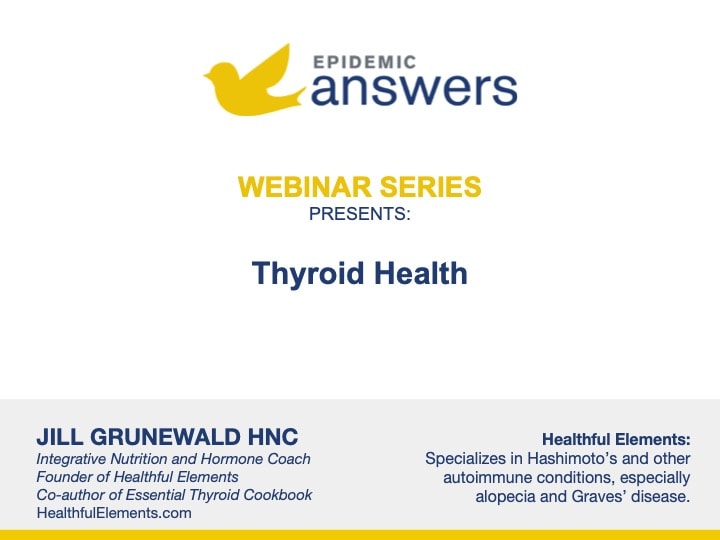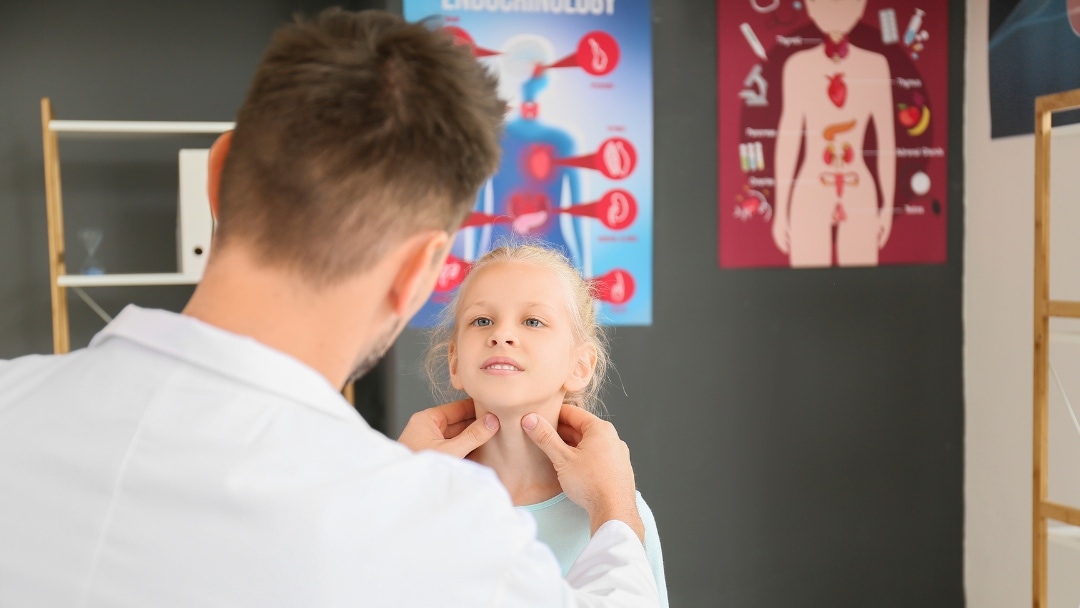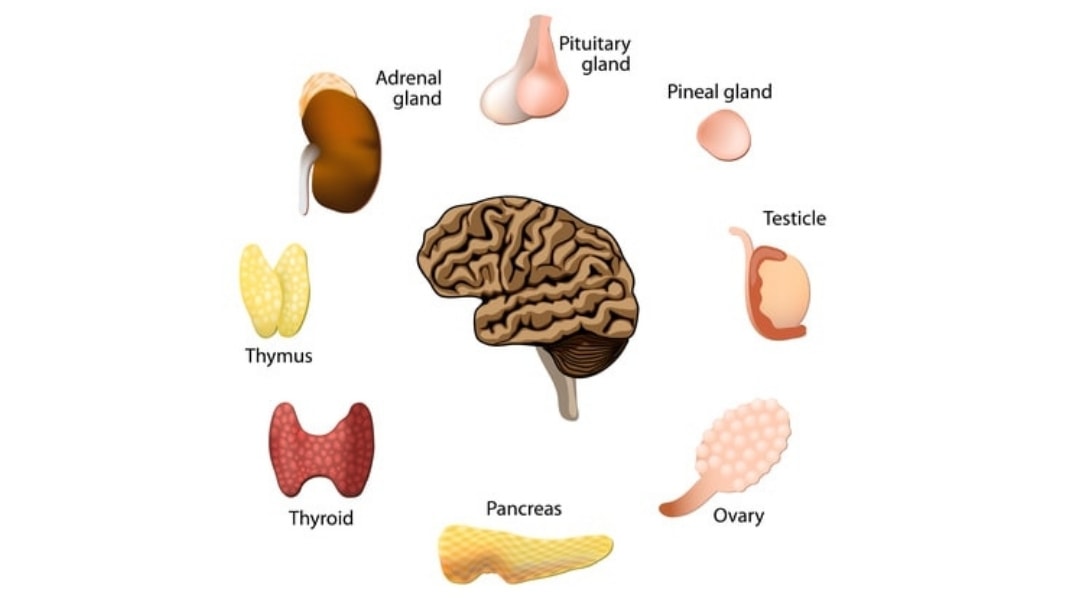What Are Thyroid Conditions?
Most childhood chronic conditions such as autism, ADHD, SPD and autoimmune disorders are often co-morbid to thyroid conditions. The thyroid gland located in the front of the neck, is responsible for all metabolic and chemical processes in the body and is a primary factor in how children grow. There are always symptoms that children experience when the thyroid is involved.
Symptoms of Hyperthyroidism
If a child has too much thyroid hormone, the condition is called hyperthyroidism (overactive thyroid). Symptoms include:
- Nervousness
- Agitation
- Being emotional more than usual
- Eating but losing weight
- Heart palpitations
- Excessive sweating
- Diarrhea
- Bulging eyes
- Trouble sleeping
Symptoms of Hypothyroidism
If a child has too little thyroid hormone, the condition is called hypothyroidism (underactive thyroid). Symptoms include:
- Sluggishness
- Low energy
- Depression
- Gaining weight when there is no change in diet or exercise
- Slow heartbeat
- Cold hands and feet
- Brittle hair
- Dry skin
- Constipation
Other Thyroid Conditions
An enlarged thyroid is called a goiter which sometimes leads to Hashimoto’s Thyroiditis, an autoimmune thyroid condition that is more common in girls. If your child has a lump in their neck and their voice changes, this may be thyroid nodules or thyroid cancer, which can cause the lymph nodes in the neck to enlarge.
An autoimmune disorder called Grave’s Disease seems to be the underlying cause of hyperthyroidism in children especially at the onset of adolescence. A child with Grave’s disease may have extreme restlessness and short attention span which can negatively affect the child’s school performance.
Ultimately, all thyroid conditions have been found to affect the growth and development of a child.
What Your Doctor May Tell You About Thyroid Disorders
Your child’s pediatrician may tell you that in some cases thyroid conditions may be hereditary. However, many children do not get enough of the mineral iodine in their diet, which can contribute to thyroid problems and to make sure you use salt with iodine on your child’s food.
Initially the doctor may want to do a physical exam on your child and blood tests on the major hormones that the thyroid makes, which are T3 (triiodothyronine) and T4 (thyroxine). Depending on the thyroid condition, the doctor may also decide to do an ultrasound or a thyroid scan if necessary.
Hyperthyroidism
If your child shows a hyperthyroidism condition, the doctor will prescribe medication to regulate the thyroid. If the problem does not resolve itself after two years, then the doctor may decide to permanently keep the thyroid from producing too much hormone by using a medication that destroys it, or he or she might decide to surgically remove it. Either way, your doctor may tell you that hyperthyroidism must be controlled so that symptoms will subside.
Hypothyroidism
Your child’s pediatrician may tell you that it is much easier to treat hypothyroidism than hyperthyroidism. For this condition, your child will likely take medication for the rest of their life to make sure that their body has enough thyroid hormone to grow and develop normally so that all symptoms will subside.
Your child’s pediatrician may also tell you that your child will need yearly blood tests and monitoring. In this way, the thyroid condition is essentially managed and kept under control with daily medication so that the child feels like normal again.
Any other more complicated thyroid conditions that do not regulate with medication will most likely be treated with surgery to remove the thyroid.
Another Way to Think About Thyroid Conditions
According to Raphael Kellman, MD, a pioneer in functional medicine specializing in microbiome, there is a surprising amount of overlap between the symptoms of low thyroid in neurotypical children and the symptoms of developmental disorders in children with learning disabilities, ADHD, developmental delays and autism. Symptoms include:
- Speech and developmental delays
- Cognitive dysfunction
- Hyperactivity
- Lethargy
- Hypotonia (low muscle tone)
- Fine motor dysfunction
- Attention disorders
- Repetitive motions
- Social dysfunction
- Communication dysfunction
- Fear
- Anxiety
- Depression
- Gastrointestinal abnormalities
- Constipation
- Feeding and eating problems
Dr. Kellman’s findings show that 75% of low thyroid function is actually missed with children with autism and other developmental delays when doctor’s only do routine testing. Dr. Kellman recommends a comprehensive evaluation and a full thyroid panel which includes levels of:
- TSH as produced through the TRH challenge
- Free T3
- Free T4
- Total T3
- Total T4
- Reverse T3
- Thyroid antibodies TgAb and TPOAb
Thyroid Conditions Healing Checklist
Use homeopathy specific for thyroid conditions
Consider using Schueller’s cell tissue salts which can be effective as well. Sequential homeopathy can also be specific for gastrointestinal symptoms if needed.
- Bromium
- Thyroidnum
- Iodum
- Calcarea carbonica
- Sepia officinalis
- Lycopodium clavatum
- Graphites
- Nux vomica
- Spongia
- Lapis alb
- Lycopus
Still Looking for Answers?
Visit the Epidemic Answers Practitioner Directory to find a practitioner near you.
Join us inside our online membership community for parents, Healing Together, where you’ll find even more healing resources, expert guidance, and a community to support you every step of your child’s healing journey.
Sources & References
Adams, J.B., et al. Mercury in first-cut baby hair of children with autism versus typically-developing children. Toxicological & Environmental Chemistry. 2007 Jun;70(12):1046-51.
Adams, J.B., et al. Mercury, Lead, and Zinc in Baby Teeth of Children with Autism Versus Controls. Journal of Toxicology and Environmental Health. 2007 Jun;70(12):1046-51.
Alampi, J.D., et al. Gestational Exposure to Toxicants and Autistic Behaviors using Bayesian Quantile Regression. Am J Epedemiol. 2021 Sep 1;190(9):1803-1813.
Mixtures of persistent organic pollutants are found in vital organs of late gestation human fetuses. Chemosphere. 2021 Nov;283:131125.
Braun, J.M., et al. Gestational exposure to endocrine-disrupting chemicals and reciprocal social, repetitive, and stereotypic behaviors in 4- and 5-year-old children: the HOME study. Environ Health Perspect. 2014 May;122(5):513-20.
Cohen, Patricia. Roundup Maker to Pay $10 Billion to Settle Cancer Suits. The New York Times. 24 Jun 2020.
Geier, M.R., et al. The potential importance of steroids in the treatment of autistic spectrum disorders and other disorders involving mercury toxicity. Med Hypotheses. 2005;64(5):946-54.
Gunatilake, S., et al. Glyphosate’s Synergistic Toxicity in Combination with Other Factors as a Cause of Chronic Kidney Disease of Unknown Origin. Int J Environ Res Public Health. 2019 Jul 31;16(15):2734.
Hansen, J.B., et al. Prenatal exposure to bisphenol A and autistic- and ADHD-related symptoms in children aged 2 and5 years from the Odense Child Cohort. Environ Health. 2021 Mar 12;20(1):24.
Harley, K.G., et al. Changes in Latina Women’s Exposure to Cleaning Chemicals Associated with Switching from Conventional to “Green” Household Cleaning Products: The LUCIR Intervention Study. Environ Health Perspect. 2021 Sep;129(9):97001.
Hauser, P., et al. Resistance to thyroid hormone: implications for neurodevelopmental research on the effects of thyroid hormone disruptors.
Toxicol Ind Health. 1998 Jan-Apr;14(1-2):85-101.
Hertz-Picciotto, I., et al. Polybrominated diphenyl ethers in relation to autism and developmental delay: a case-control study. Environ Health. 2011 Jan 5;10(1):1.
Hinhumpatch, P., et al. Oxidative DNA damage and repair in children exposed to low levels of arsenic in utero and during early childhood: application of salivary and urinary biomarkers. Toxicol Appl Pharmacol. 2013;273(3):569-79.
Holmes, A., et al. Reduced Levels of Mercury in First Baby Haircuts of Autistic Children. International Journal of Toxicology. Jul-Aug 2003;22(4):277-85.
Jafari, M.H., et al. The Relationship Between the Level of Copper, Lead, Mercury and Autism Disorders: A Meta-Analysis. Pediatric Health, Medicine and Therapeutics. 21 Sep 2020(11):369—378.
Jafari, T., et al. The association between mercury levels and autism spectrum disorders: A systematic review and meta-analysis. J Trace Elem Med Biol. 2017 Dec;44:289-297.
Julvez, J., et al. Early life multiple exposures and child cognitive function: A multi-centric birth cohort study in six European countries. Environ Pollut. 2021 Sep 1;284:117404.
Kern, J.K., et al. A biomarker of mercury body-burden correlated with diagnostic domain specific clinical symptoms of autism spectrum disorder. Biometals. 2010;23(6):1043-51.
Konkel, L. Phthalates and Autistic Traits: Exploring the Association between Prenatal Exposures and Child Behavior. Environ Health Perspec. 2020 Oct;128(10):104001.
Landrigan, P.J., et al. Children’s vulnerability to toxic chemicals: a challenge and opportunity to strengthen health and environmental policy. Health Aff. (Millwood). 2011 May;30(5):842-50.
Lombardi, C., et al. Residential proximity to pesticide application as a risk factor for childhood central nervous system tumors. Environ Res. 2021 Jun;197:111078.
Lyall, K., et al. Prenatal Serum Concentrations of Brominated Flame Retardants and Autism Spectrum Disorder and Intellectual Disability in the Early Markers of Autism Study: A Population-Based Case-Control Study in California. Environ Health Perspect. 2017 Aug 30;125(8):087023.
Messer, A. Mini-review: polybrominated diphenyl ether (PBDE) flame retardants as potential autism risk factors. Physiol Behav. 2010 Jun 1;100(3):245-9.
Napoli, E., et al. Toxicity of the flame-retardant BDE-49 on brain mitochondria and neuronal progenitor striatal cells enhanced by a PTEN-deficient background. Toxicol Sci. 2013 Mar;132(1):196-210.
Napolitano, G., et al. Is zinc deficiency a cause of subclinical hypothyroidism in Down syndrome? Ann Genet. 1990;33(1):9-15.
Palmer, R.F., et al. Proximity to point sources of environmental mercury release as a predictor of autism prevalence. Health and Place. 2009 Mar;15(1):18-24.
Peltier, M.R., et al. Maternal Hypothyroidism Increases the Risk of Attention-Deficit Hyperactivity Disorder in the Offspring. Am J Perinat. 2020 Oct 21.
Samsel, A., et al. Glyphosate, pathways to modern diseases II: Celiac sprue and gluten intolerance. Interdiscip Toxicol. 2013 Dec;6(4):159-84.
Samsel, A., et al. Glyphosate, pathways to modern diseases III: Manganese, neurological diseases, and associated pathologies. Surg Neurol Int. 2015 Mar 24;6:45.
Samsel, A, et al. Glyphosate’s suppression of cytochrome P450 enzymes and amino acid biosynthesis by the gut microbiome: Pathways to modern diseases. Entropy. 2013;15:1416–1463.
Venâncio, P., et al. Anti-N-methyl-D-aspartate receptor encephalitis with positive serum antithyroid antibodies, IgM antibodies against mycoplasma pneumoniae and human herpesvirus 7 PCR in the CSF. Pediatr Infect Dis J. 2014 Aug;33(8):882-3.
Wang, H.L., et al. Case-Control Study of Blood Lead Levels and Attention Deficit Hyperactivity Disorder in Chinese Children. Environmental Health Perspectives. 2008 Oct;116(10):1401-6.
Watt, T., et al. Is Thyroid Autoimmunity per se a Determinant of Quality of Life in Patients with Autoimmune Hypothyroidism? Eur Thyroid J. 2012;1(3):186-92.
Wong, S., et al. Autism, Mitochondria and Polybrominated Diphenyl Ether Exposure. CNS Neurol Disord Drug Targets. 2016;15(5):614-23.
Xu, C.L., et al. Anti-N-methyl-D-aspartate receptor encephalitis with serum anti-thyroid antibodies and IgM antibodies against Epstein-Barr virus viral capsid antigen: a case report and one year follow-up. BMC Neurol. 2011 Nov 29;11:149.
Resources
Articles
The Environmental Working Group. Body Burden: The Pollution in Newborns. 14 Jul 2005.
Swan, Shanna, et al. Reproductive Problems in Both Men and Women Are Rising at an Alarming Rate: A likely culprit is hormone-disrupting chemicals. Scientific American, 16 Mar 2021.
Books
Hong, Maria Rickert. Almost Autism: Recovering Children from Sensory Processing Disorder, A Reference for Parents and Practitioners. 2014.
Markley, Lisa, et al. The Essential Thyroid Cookbook: Over 100 Nourishing Recipes for Thriving with Hypothyroidism and Hashimoto’s. Blue Wheel Press, 2017.
Perro, Michelle, et al. What’s Making Our Children Sick?: How Industrial Food Is Causing an Epidemic of Chronic Illness, and What Parents (and Doctors) Can Do About It. Chelsea Green Publishing, 2017.
Rogers, Sherry. Detoxify or Die. Prestige Publishing, 2002.
Wachter, Kenneth W., et al. Offspring: Human Fertility Behavior in Biodemographic Perspective. National Academy of Sciences, 2003.
Videos
A Global Fertility Crisis – Dr. Shanna Swan




